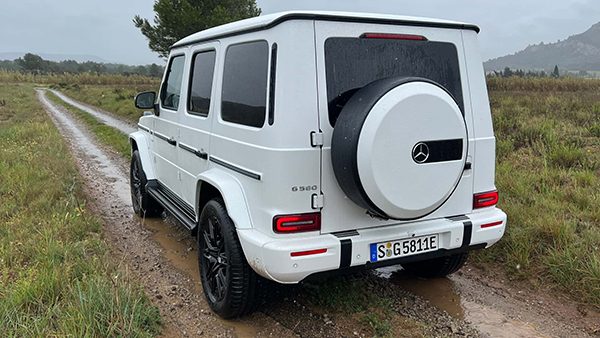Don’t ruin a good thing. That’s how the saying goes. And for the last 45 years, the G-Wagen has been a very good thing. The monolithic box on wheels has evolved through the decades, but it’s always looked roughly the same. For its American audience, it’s always had a big, powerful internal-combustion engine.

Mercedes adding an electric powertrain to its most iconic model has the potential for disaster, especially considering faltering electric car sales and the company’s lackluster EV offerings so far. But after a brief stint behind the wheel of the new electric G-Class and a tortuous off-road test, it’s clear prospective buyers have nothing to worry about. In fact, the G580 with EQ Technology (as it’s so awkwardly named) is the most capable off-roader in the G lineup right now.
From many angles, the electric G-Wagen is not unlike other G-Wagens. The shape and proportions are the same. The face may wear a raccoon-like mask, but those big, round headlights are clear identifiers. Out back, the spare tire is replaced with a squared-off box to hold things like charging cords and adapters (the spare tire can be optioned back in place if you so desire, or you can have neither). Walk up and open the doors, and that familiar heavy metallic latch ka-chunk is present and accounted for. By all measures so far, the G580 is a true G-Class.
Things continue when you step inside. The electric G shares its cabin with the gas-powered trims, down to the dual-screen dashboard layout, column shifter, and physical climate control array. In fact, the only real difference lies in the center of the dash, where the three differential buttons have been replaced. The center button is now used for Low Range, while the outer two buttons activate two new features exclusive to the G580: G-Turn and G-Steering.
G-Turn is Mercedes’ fancy name for a tank turn, where the left- and right-side wheels spin opposite of each other, allowing the electric G-Wagen to rotate in place. Though we suspect most owners will use the feature as a gimmick to go viral on TikTok, it has real potential in the off-road world. If you’ve ever reached a dead end on a tight dirt path in the middle of a snowy forest, you’ll understand just how valuable a G-Turn can be.

G-steer effectively cuts the turning circle of the G-Class by dragging the rear inside wheel and over-driving the outside wheels—perfect for making those 180-degree corners on your local mountain pass.
Both of these feats are possible thanks to the G580’s drivetrain setup. There are four electric motors, one for each wheel. Because they can be controlled independently, stuff like the G-Turn is as simple as pressing the button on the dash, holding a paddle on the steering wheel, and mashing the accelerator pedal. G-Steer is even easier; all you have to do is press the button to activate it and point the steering wheel where you want to go. The system does all the hard work, ensuring you’ll get by without three-point turns again. Try that with a gas-powered G-Class.
The electric G’s off-road supremacy doesn’t end there. Pressing that Low Range button in the center of the dash doesn’t just activate some software in the ECU. There are real, actual two-speed transfer cases built into each electric motor, giving the G580 true low-speed control and markedly more twist at crawling speeds—exactly what you want for off-roading.
The more cynical among us can argue the electric G-Wagen’s lack of real differentials gives the gas-powered G-Class an edge. The G580 makes do with “virtual” differential locks, made possible by torque vectoring. Mercedes says it can meter torque between each axle within “fractions of a second” to ensure smooth, even power delivery no matter the terrain. The virtual diffs work automatically when you’re in low range, so you don’t have to worry about activating or deactivating each one depending on your next obstacle.

In practice, the virtual differentials work just as well as the real things. After driving a gas-powered G-Wagen back to back with the electric G, both trucks delivered the same incredible rock-crawling performance up some truly challenging, rain-soaked terrain. And unlike the gas version, I didn’t have to keep an eye on whether my front diff was locked. The truck assessed the terrain automatically, making black diamond trails feel like a walk through the local strip mall parking lot.
These types of trails require more than your standard metal skid plate to protect the ladder frame-mounted battery pack. Mercedes says it’s developed an underbody plate it describes as a “carbon-fiber sandwich.” In between two layers of carbon fiber is a type of wood, according to one of the truck’s engineers. Held to the battery with 50 steel fasteners, it’s more rigid than steel or aluminum and weighs 127 pounds (about a third of a comparable steel component).
Rock crawling isn’t the only place where the battery-powered G-Wagen outperforms. It can also ford more water than the gas-powered G-Wagen: 33.5 inches of fording depth versus just 27.6 inches for the G550 and the G63. Because the motors and battery are sealed, the G580 doesn’t have to consider sucking in water and damaging sensitive equipment. During our rainy test session, the electric G had no trouble driving in water deep enough to touch the bottom of the windows. In this scenario, the motors and the battery are fully submerged. This is a true G-Wagen, through and through.
On the road the G580 with EQ Technology performs just as well as the gas-powered G550. Steering and body control are nice and balanced, while an upright driving position and windshield make you feel like king of the road. Those four motors make a combined 579 horsepower and 859 pound-feet of torque. Under 100 mph the electric G feels just as quick as the V-8-powered G63, delivering the instant gut-punch of thrust we’ve all come to expect from high-output electric cars.

It’s only when you push the G580 past 7/10ths that its composure falls apart. Because it’s corralling so much weight (the European example we drove weighed 6,801 pounds), the truck’s suspension tends to develop a floaty feeling during high-speed dynamic driving. The G never really settles to a point where you feel comfortable going quickly. We don’t suspect many owners will hit canyon roads regularly in their G-Wagen EV, though.
You can drive the electric G-Class in complete silence, or you can turn on what Mercedes calls the G-Roar. As the cringey name implies, it’s a sort of virtual exhaust note that plays within the cabin as you accelerate. It doesn’t sound like a V-8—engineers specifically said they didn’t want it to sound like a V-8. Instead, it’s a weird mix between an inline-four and a spaceship. It’s there mainly to give passengers a sense of speed so they don’t become carsick, and it’s not nearly as impressive as the synthetic exhaust note Hyundai is doing right now with the Ioniq 5 N. If it were my truck, I’d turn G-Roar off and never think of it again.
While Mercedes has yet to release pricing or EPA-estimated range, we can make some educated guesses. It’s safe to expect the G580 to start around the same price as the G63, meaning an MSRP of just below $190,000. And by doing some quick math with range estimates we saw on the dashboard during our test, we put the driving range at about 224 miles.
That’s a rough estimation, but considering the G580’s weight and shape, it sounds like a reasonable number. While that might turn some buyers off, we suspect most prospective owners of the electric G-Class will have more than one car in their garage, making long-range travel irrelevant. All the things that really matter to those buyers—presence, comfort, and unmatched off-roadability—are still here. And in most cases, it performs better than the gas version.
Mercedes-Benz G-Class EV Is Better Than The Gas Version
27/05/2024
No Comments
Mercedes-Benz | Mercedes-AMG
Click to rate this post
[Total: 1 Average: 5]